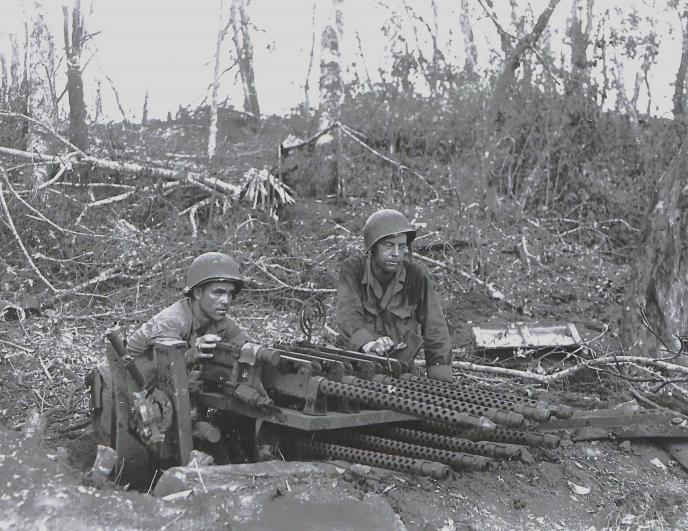-
Contributing Member


OT Japanese MG

Japanese HO-103 variant of the M2 HMG in an 8-gun linked AA mount converted for anti-infantry use by American forces in the Pacific after it's capture.
HO-103 variant of the M2 HMG in an 8-gun linked AA mount converted for anti-infantry use by American forces in the Pacific after it's capture.
One of the design engineers I worked with in the late 70s said he had worked on a pneumatic automatic rifle system that would fire one-inch dia. lead balls fed from a hopper when they tried it out it mowed down the forest.
He is no fool who gives what he cannot keep to gain that which he cannot lose
There are no great men, only great challenges that ordinary men are forced by circumstances to meet.
-
The Following 9 Members Say Thank You to Mark in Rochester For This Useful Post:
-
04-19-2024 07:50 PM
# ADS
Friends and Sponsors

-
Advisory Panel


What a pig that would be to keep operating, I don't care who built it or assembled it. A mechanical nightmare.
"Japanese HO-103 variant of the M2 HMG in an 8-gun linked AA mount converted for anti-infantry use by American forces in the Pacific after it's capture. The Type 1 HO-103 was largely based on the American .50-caliber (12.7 mm) M2 Browning heavy machine gun, while the design of its ammunition was Italian
HO-103 variant of the M2 HMG in an 8-gun linked AA mount converted for anti-infantry use by American forces in the Pacific after it's capture. The Type 1 HO-103 was largely based on the American .50-caliber (12.7 mm) M2 Browning heavy machine gun, while the design of its ammunition was Italian Breda-SAFAT 12.7 mm rounds. Japanese-designed and produced rounds would eventually mostly replace these imported rounds.
Breda-SAFAT 12.7 mm rounds. Japanese-designed and produced rounds would eventually mostly replace these imported rounds.
The Ho-103 achieved a slightly higher rate of fire (RoF) than the contemporary aircraft-mounted M2 Browning machine gun (AN/M2) by using the smaller, lower velocity semi-rimmed Breda-SAFAT 12.7 mm cartridge. The round was intermediate in length (88 mm) between the WWII German 13 mm calibre MG 131's ‘short’ 64 mm cartridge, and the ‘long’ 99 mm cartridge of the M2 Browning. A high RoF was very desirable among aircraft weaponry; With the ever-increasing speeds of fighters, the window to score hits grew smaller and smaller. Thus, a higher RoF provided a greater density of fire and therefore a greater chance to hit. The compromise of a shorter cartridge to achieve this had drawbacks; Ho-103 rounds had a shorter maximum and effective range, as well as a lower velocity than their M2 Browning counterparts.
13 mm calibre MG 131's ‘short’ 64 mm cartridge, and the ‘long’ 99 mm cartridge of the M2 Browning. A high RoF was very desirable among aircraft weaponry; With the ever-increasing speeds of fighters, the window to score hits grew smaller and smaller. Thus, a higher RoF provided a greater density of fire and therefore a greater chance to hit. The compromise of a shorter cartridge to achieve this had drawbacks; Ho-103 rounds had a shorter maximum and effective range, as well as a lower velocity than their M2 Browning counterparts.
To compensate for the loss in performance, the gun was frequently loaded with high-explosive incendiary (HEI) rounds. The Italian Breda-SAFAT HEI ammunition was initially copied as the fuzed Ma 103 round, until the fuzeless Ma 102 round was developed, carrying over double the high explosive content of the Ma 103."
-
The Following 8 Members Say Thank You to browningautorifle For This Useful Post:
-
-
Legacy Member

Brings a whole new light to the term "Withering Enemy Fire"................
-
Thank You to RAM1ALASKA For This Useful Post:
HO-103 variant of the M2 HMG in an 8-gun linked AA mount converted for anti-infantry use by American forces in the Pacific after it's capture.
















 PM
PM







